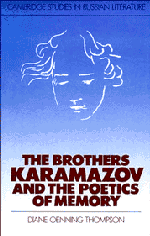Book contents
- Frontmatter
- Contents
- Preface
- Note on the text
- 1 Memory and poetics
- 2 The fictional narrator
- 3 Memory and the system of ascending plots
- 4 The memories of the characters: forms of affirmative memory
- 5 The memories of the characters: forms of negative memory
- 6 Forgetting
- 7 Foretelling
- 8 The Christocentric poetic memory system
- 9 Afterword
- Notes
- Bibliography
- Index
- Titles in the series
4 - The memories of the characters: forms of affirmative memory
Published online by Cambridge University Press: 05 November 2011
- Frontmatter
- Contents
- Preface
- Note on the text
- 1 Memory and poetics
- 2 The fictional narrator
- 3 Memory and the system of ascending plots
- 4 The memories of the characters: forms of affirmative memory
- 5 The memories of the characters: forms of negative memory
- 6 Forgetting
- 7 Foretelling
- 8 The Christocentric poetic memory system
- 9 Afterword
- Notes
- Bibliography
- Index
- Titles in the series
Summary
Their memorie Shall as a Patterne, or a Measure, live.
Henry IV Part IIALYOSHA: ICONOGRAPHY AND HAGIOGRAPHY
When analysing the characters' memories, we soon find that we have to divide them into two main categories, those that affirm the system of Christian memory and those that negate it. To the affirmative category belong above all the memories of the hero. Alyosha is the only brother whom the narrator introduces into his expository retrospect of Book One with a specific memory from childhood.
After briefly recounting the tragic life of Alyosha's mother, the narrator brings his hero into the family history with the following remark: ‘When she died Alyosha was going on four and although it is strange, I know that he remembered his mother afterwards for all his life, – like through a dream, to be sure’ (14,13). There is already discernible in his utterance about Alyosha a more intimate, partial accent, absent from his chronicling of the other characters’ lives. This has to do with the way the narrator's memory meets that of his hero. Significant for poetic memory is the narrator's implicit positioning of himself at a point where he has a perspective on Alyosha's whole life. In fact, he is now, for the sake of narration, remembering that his hero remembered his mother for ‘all his life’. He personally vouches (‘I know’) for the truth of his hero's memory.
- Type
- Chapter
- Information
- The Brothers Karamazov and the Poetics of Memory , pp. 74 - 125Publisher: Cambridge University PressPrint publication year: 1991
- 1
- Cited by

